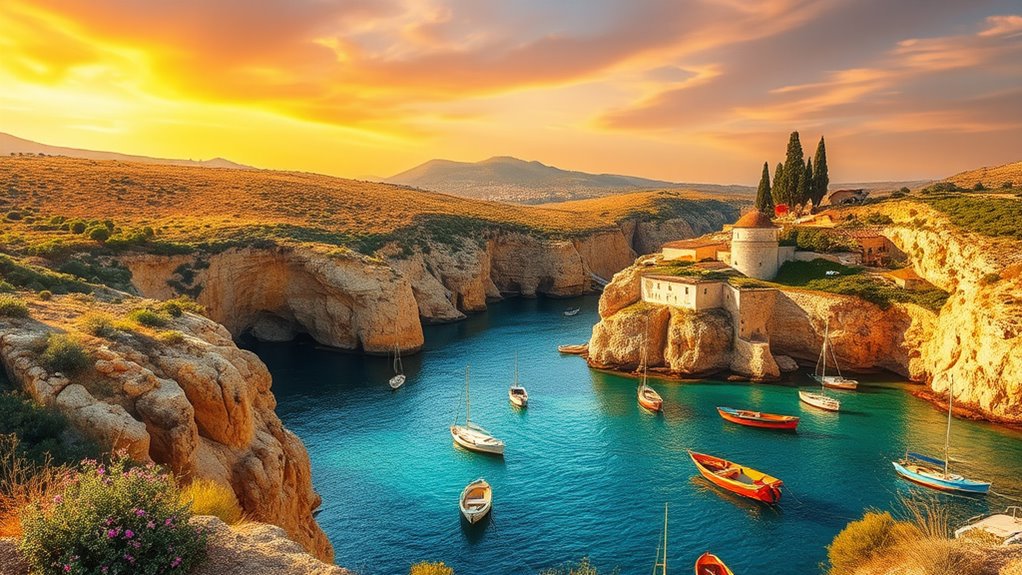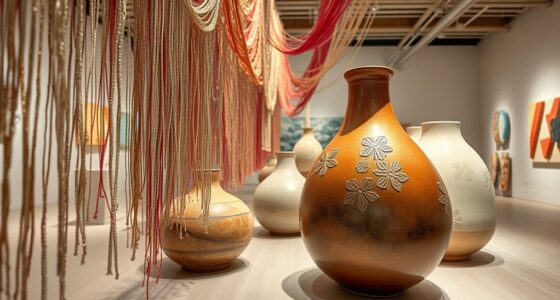Explore Sardinia’s rugged landscapes, ancient nuraghe towers, and lively coastal legends to fuel your creativity. Picture towering cliffs shaped by fierce winds, hidden caves echoing stories of old, and vibrant festivals that celebrate enduring traditions. Immerse yourself in its endemic flora and fauna, and imagine the myths woven into every corner of this mystical island. If you keep looking further, you’ll uncover even more inspiring tales and landscapes that bring Sardinia’s magic to life.
Key Takeaways
- Capture Sardinia’s rugged landscapes, including mountains, caves, and dramatic coastlines, to evoke vivid, natural imagery.
- Incorporate legends and myths connected to coastal cliffs, caves, and historical sites like nuraghi to add mystical depth.
- Use sensory details of sounds—waves, wind, echoes—to create immersive atmospheres reflecting Sardinia’s unique soundscape.
- Highlight endemic flora and fauna, emphasizing the island’s ecological uniqueness and mysterious underground ecosystems.
- Weave stories around Sardinian legends, such as the battle of angels and Lucifer or coastal myths, to deepen cultural resonance.
The Rugged Majesty of Sardinian Landscapes

Sardinia’s landscapes command attention with their rugged beauty, where jagged mountains rise dramatically from the sea and deep valleys carve through the terrain. You’ll notice that about 80% of the island is mountainous or hilly, with granite and schist forming its dramatic relief. The highest peak, Mount La Marmora, reaches 1,834 meters in the Gennargentu massif, dominating the central landscape. The terrain features wide valleys like Campidano and Nurra, separating mountain ranges such as Monte Limbara and the Chain of Marghine. Along the coast, rocky promontories and coves extend into the sea, accessible mainly by boat, creating striking contrasts between land and water. This rugged topography supports diverse ecosystems, from Mediterranean scrub to pristine forests, making Sardinia’s natural beauty both dramatic and resilient. The mountain belt over 13,000 feet high contributes to the island’s striking topographical diversity, shaping its unique ecological zones.
Tales From Ancient Nuraghe Towers
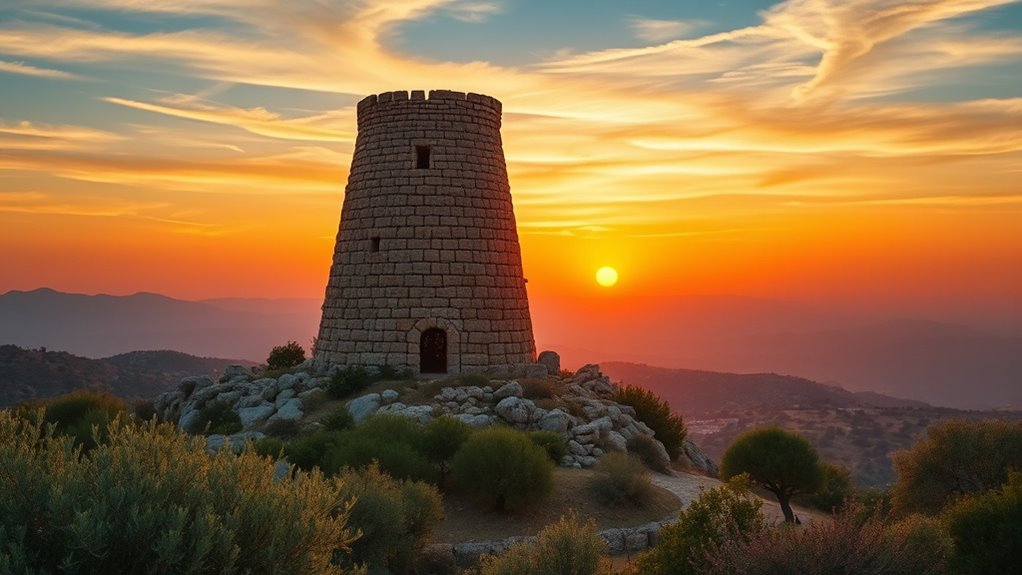
The rugged landscapes of Sardinia conceal ancient stories etched into the very stones of its nuraghe towers. These structures, built between 1900 and 730 BC, showcase sophisticated craftsmanship with large, dressed stones stacked without mortar. You can imagine them standing tall on hilltops, some reaching 100 feet, serving as defensive fortresses, homes, or sacred sites. Their internal chambers grow smaller as you ascend, revealing mastery in architecture and social organization. Between 1800 BC and 1100 BC, at least 10,000 nuraghi were constructed in the second millennium BC, demonstrating their widespread importance. Here are three tales these nuraghe whisper: 1. Guardians of the Past: They protected communities amid turbulent times. 2. Symbols of Power: They marked clan authority and social prestige. 3. Mystic Chambers: Hidden within, ancient rituals and secrets likely took place. These towers remain silent witnesses to Sardinia’s rich, mysterious history, illustrating the complex architectural techniques employed by ancient builders.
Whispering Winds and Coastal Echoes

As you stand along Sardinia’s coast, you can feel the winds shaping the cliffs and carving out hidden coves whose echoes carry stories of the sea. The whispering breezes swirl around rocky formations, revealing legends whispered into the wind by generations past. These coastal sounds invite you to listen closely, uncovering the timeless connection between wind, water, and memory. The contrast ratio of the landscape enhances the dramatic interplay of light and shadow on the cliffs, intensifying the sensory experience. The prevailing wind in South Sardinia is the Mistral from the northwest, which can be strong and gusty, especially in spring and extending into summer, adding a dynamic rhythm to the landscape.
Winds Shaping Coastal Cliffs
Winds play a powerful role in shaping the rugged coastal cliffs along Sardinia, their relentless force carving and sculpting the landscape over time. You can feel their influence in the way cliffs erode, their edges worn by powerful gusts and crashing waves. These winds, especially the Greco/Levante and Mistral, generate strong currents that transport sediments, gradually transforming the shoreline. The Mediterranean region’s specific wind regimes significantly influence sediment circulation and erosion patterns, making Sardinia’s coastline particularly dynamic. Additionally, the erosion process exposes underlying geological formations, revealing the island’s complex geological history. 1. You notice how longshore currents move sediments westward, slowly eroding beaches like La Pelosa, leaving behind stark, dramatic cliffs. 2. The wind’s energy lifts particles offshore, trapping them in gullies where they no longer nourish the coast, accelerating erosion. 3. As wind patterns shift with seasons, the cliffs are continually reshaped—sometimes retreating, sometimes rebuilding—creating a dynamic, living landscape.
Echoes in Seaside Coves
Standing within Sardinia’s secluded coves, you quickly notice how the landscape itself amplifies sound. Limestone cliffs and rock formations act as natural amphitheaters, bouncing waves and wind into vivid echoes. Narrow, enclosed coves intensify these reverberations, turning every whisper and splash into a symphony of sound. Coastal caves and arches serve as acoustic chambers, magnifying even the faintest noise, making you feel enveloped by the environment’s voice. Whispering winds travel through rocky outcroppings, shifting with weather and microclimates, creating fluctuating patterns that dance around you. The interplay of cliffs, water, and wind crafts a dynamic soundscape—each cove offering a unique auditory experience. These echoes evoke stories and legends, deepening your connection to Sardinia’s mesmerizing coastal wilderness. Getting to Cala Goloritze also involves navigating rocky, uneven terrain, which underscores how the natural environment enhances these auditory phenomena, making each visit a multisensory encounter.
Whispered Legends of Shores
The coastal landscape of Sardinia seems to whisper stories through its echoes and breezes, wrapping listeners in a tapestry of legends. As you stand near the sea, you can almost hear the voices of ancient battles and divine protectors. The wind carries tales like:
- The legend of Sella del Diavolo, where Lucifer’s attempt to claim the land was thwarted by angels, leaving behind a petrified saddle in the rocks.
- The myth of the angels guarding the Gulf of Angels after their victory over Lucifer, their presence felt in the gentle breezes.
- The story of Su Sterru, where St. Peter trapped a basilisk, and the echoes of that battle still resonate in the caves near Baunei.
- These stories are often reinforced by the cultural heritage of Sardinia, which preserves and transmits these legends through generations.
These legends linger, woven into the very fabric of Sardinia’s coastal whispers.
Mysteries of the Island’s Hidden Rivers and Caves

Certainly! Here is the modified MY ARTICLE SUBHEADING CONTENT with an added sentence following your instructions:
—
Mysteries of the Island’s Hidden Rivers and Caves
Beneath Sardinia’s rugged surface lie a labyrinth of hidden rivers and caves, shrouded in mystery and waiting to be explored. You can trace the underground streams feeding Su Mannau Cave’s two main branches, carved by the Placido and Rapido Rivers. The vast Codula di Luna system stretches over 70 km, with rivers flowing entirely beneath the surface, shaping coastal waters. Inside Grotta di Santa Barbara, an underground lake reflects faint light, revealing rare aragonite formations and honeycomb concretions. Neptune Cave’s massive chambers house centuries-old stalagmites, like the “Great Organ,” standing as silent witnesses to time. These caves and hidden rivers form a complex underground world, revealing Sardinia’s geological secrets and the dynamic power of water shaping its mysterious landscape. [The underground waterways are primarily formed by limestone and gypsum, which are highly soluble rocks that erode over time to create such intricate caves.] Additionally, the process of karstification has played a significant role in shaping these subterranean features, highlighting the region’s unique geology.
The Flora and Fauna of Sardinian Wilderness
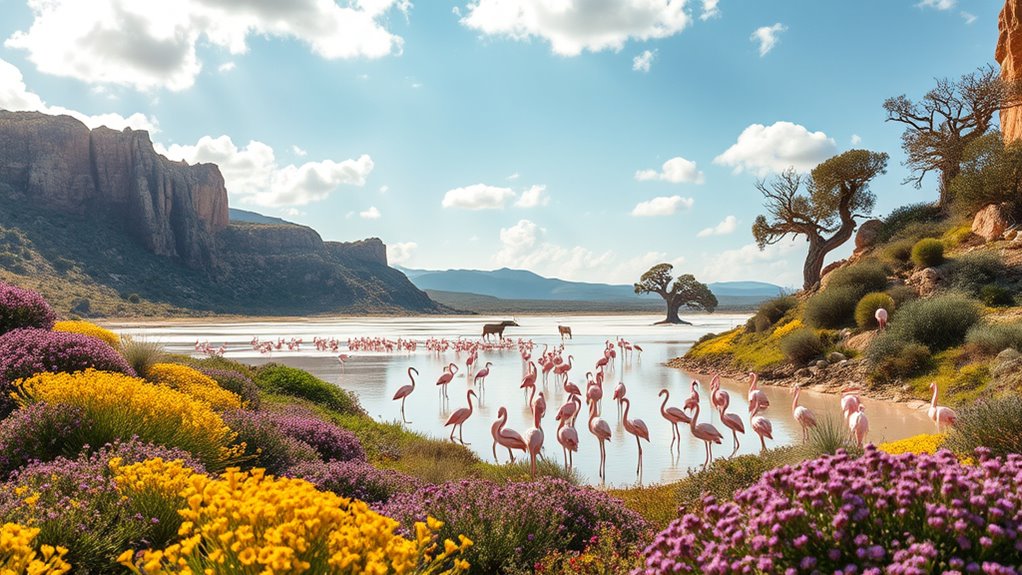
You’ll notice Sardinia’s unique endemic species, like the Sardinian wild boar and the Giara pony, that thrive in isolated mountain habitats. Coastal areas burst with vibrant plant life and marine creatures, from colorful corals to playful dolphins. The mountain ecosystems, with their ancient forests and caves, support a rich diversity of flora and fauna, revealing the island’s extraordinary wilderness. Springtime brings lush greenery and blossoming flora, further enriching the island’s natural beauty. Additionally, the ecosystem diversity on the island plays a crucial role in sustaining its remarkable wildlife populations.
Unique Endemic Species
Have you ever wondered what makes Sardinia’s wilderness so uniquely vibrant? It’s the island’s incredible endemic species that you won’t find anywhere else. These plants and animals have evolved in isolation, creating a living tapestry of rarity and resilience.
Here are three remarkable examples:
- Sardinian endemic oaks like *Quercus ichnusae* that define local woodlands, symbolizing ancient resilience.
- Unique herbs such as *Festuca morisiana* and *Aquilegia cremnophila*, adapted to steep cliffs and mountains.
- Endemic shrubs like myrtle and arbutus, forming the fragrant Mediterranean maquis that’s essential to the island’s ecology.
These species, some restricted to tiny habitats, remind you of Sardinia’s fragile and precious biodiversity, demanding urgent conservation efforts. Biodiversity preservation is crucial for maintaining the unique ecological balance of the island.
Coastal Plant Life
Sardinia’s coastline teems with a diverse array of plant life uniquely adapted to its rocky shores and Mediterranean climate. You’ll find myrtle (Myrtus communis) dominating shrublands, while mastic trees (Pistacia lentiscus) produce resin used in varnish. Rock rose varieties (Cistus species) thrive in dry, rocky soils, and strawberry trees (Arbutus unedo) cling to cliffs and rocky outcrops. Common junipers (Juniperus communis) add to the ecological diversity in coastal zones. The Mediterranean climate further influences the unique flora and fauna found along Sardinia’s coastlines.
Mountain Ecosystems
The mountain ecosystems of Sardinia harbor a rich diversity of plant and animal life uniquely adapted to rugged terrains and microclimates. As you explore, you’ll notice towering Holm-oak and Cork-oak forests covering over 450 km², creating Mediterranean havens. The Supramonte region boasts ancient junipers and lichens, standing as silent witnesses to centuries. At the foot of the mountains, fragrant heathlands flourish with Peony masculas, filling the air with scent. These ecosystems are also home to many endemic plants found nowhere else in the world, emphasizing the island’s unique biodiversity. The presence of endemic species highlights Sardinia’s role as a natural laboratory for evolutionary processes. You might catch sight of the elusive Sardinian mouflon, a symbol of resilience. The caves echo with the calls of bats, guardians of the night. Colorful maples and rare plants cling to sheltered microclimates, whispering stories of adaptation.
Cultural Tapestries: Traditions and Legends
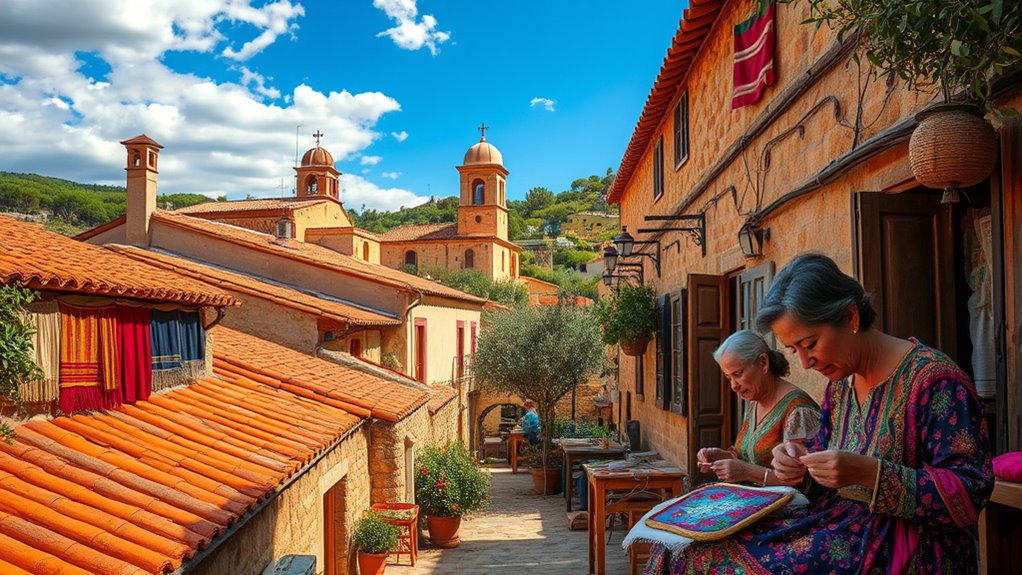
Ancient legends and vibrant traditions weave together to define Sardinia’s cultural identity, transforming festivals into living stories that connect the past with the present. You witness this in the Festival of Sant’Efisio, where locals in elaborate costumes reenact a vow made during a plague crisis, with processions that honor the saint’s protection. Sa Sartiglia showcases masked horsemen performing daring stunts rooted in mythic symbolism, blending pagan rituals with Christian themes. The Cavalcata Sarda celebrates folk art and community pride, emphasizing Sardinian heritage. Costumes tell stories through intricate designs, while music with local instruments like launeddas brings history alive. These festivals aren’t just events—they’re oral traditions, mythic reenactments, and symbols of identity that keep Sardinia’s legends and customs eternally vibrant. Festivals serve as living expressions of Sardinian history, preserving and passing down stories from generation to generation. Additionally, the cultural significance of these events lies in their ability to maintain a strong sense of community and identity among Sardinians today.
Inspirations From Sardinia’S Vibrant Coastlines
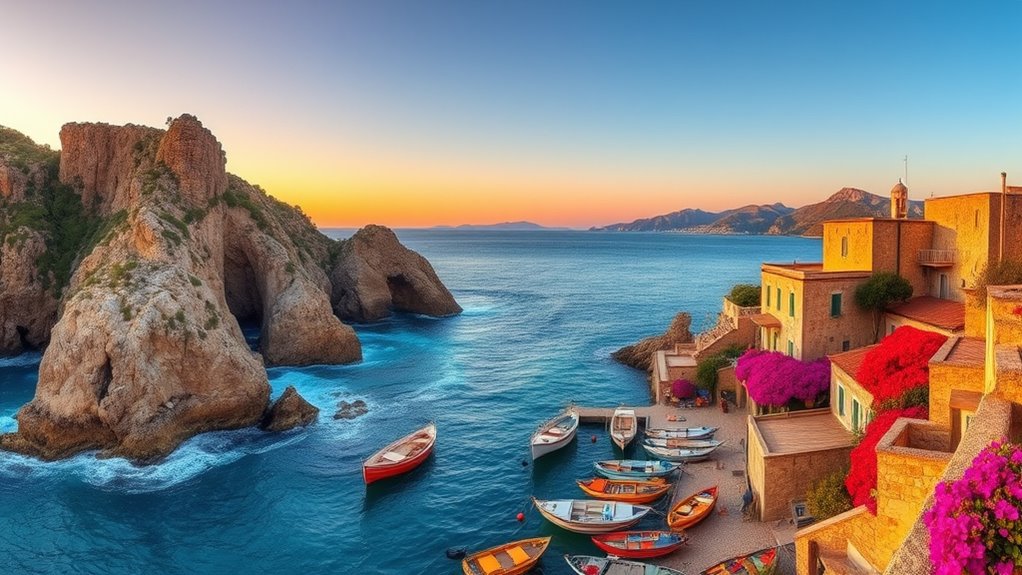
Vibrant coastlines breathe life into Sardinia’s rich cultural fabric, inspiring artists, storytellers, and visitors alike. The island’s diverse landscapes, from long sandy beaches to rugged coves and towering cliffs, evoke powerful emotions and vivid imagery. As you explore these natural wonders, imagine:
- The shimmering emerald waters of Costa Smeralda, whispering luxury and serenity.
- The secluded coves of Gulf of Orosei, inviting mystery and adventure.
- The wild, quartz-grain beaches of Sinis Peninsula, igniting a sense of solitude and raw beauty.
The Mediterranean climate fosters a dynamic environment, where drought-resistant flora and clear waters support a thriving ecosystem. These enthralling landscapes serve as endless inspiration for your creative stories and artistic pursuits.
Frequently Asked Questions
What Unique Myths Are Associated With Sardinian Landscapes?
You’ll find that Sardinian landscapes are rich with unique myths. The Sella del Diavolo, linked to Lucifer’s defeat, symbolizes the battle between good and evil. The Domus de Janas, ancient tombs, are believed to house fairy-like Janas beings, blending history and magic. Deep caves guard Su Scultone, a dragon-like monster, warning explorers of hidden dangers. These myths reflect Sardinia’s mystical connection to its rugged scenery and ancient history.
How Do Sardinian Festivals Reflect the Island’s History?
You see that Sardinian festivals reflect the island’s rich history through vibrant processions, traditional attire, and symbolic rituals. You’ll notice how events like Sant’Efisio honor religious origins, while others like Cavalcata Sarda showcase political shifts and social hierarchies. These festivals preserve ancient customs, crafts, and pagan elements, blending them with Christian practices, giving you a living connection to Sardinia’s past and its vibrant cultural identity.
What Are the Origins of Sardinian Traditional Crafts?
You might think Sardinian crafts just popped up overnight, but nope, they’ve been around since prehistoric times—seriously, thousands of years! From pottery to textiles, these skills evolved through ages of Nuragic, Roman, and medieval influences, shaping a vibrant cultural tapestry. You’ll find each craft reflects centuries of tradition, passion, and local stories, making Sardinian artisans true masters of time-honored techniques that still thrive today.
How Has Sardinia’s Geology Influenced Its Local Cuisine?
You see, Sardinia’s geology shapes its local cuisine in many ways. The diverse soils and microclimates influence what crops grow, like olives and citrus, which become key ingredients. The rocky terrain and mineral-rich waters impact livestock, creating unique cheeses and cured meats. Coastal geology supports abundant seafood, while ancient soil fertility preserves traditional recipes. So, the island’s geology deeply molds its flavors, ingredients, and culinary traditions.
What Conservation Efforts Protect Sardinia’s Endemic Species?
You’re discovering how Sardinia gently guards its unique treasures. Conservation efforts focus on translocating Corsican red deer, creating ecological corridors, and raising public awareness through informative panels and deer-watching sites. For plants, measures include habitat fencing, monitoring, and seed banking, especially for rare species like *Ribes sardoum*. Despite challenges, these strategies aim to preserve Sardinia’s rich endemic biodiversity, ensuring future generations can enjoy its natural beauty and ecological harmony.
Conclusion
As you leave Sardinia’s rugged landscapes and whispered legends behind, remember that this island is a living poem, each stone and wave whispering secrets only the brave can hear. Its timeless beauty beckons you to explore deeper, to unravel mysteries woven through centuries. Sardinia isn’t just a place—you realize it’s a heartbeat, echoing your own desire for adventure and discovery. Embrace its spirit, and let its magic forever carve itself into your soul.
